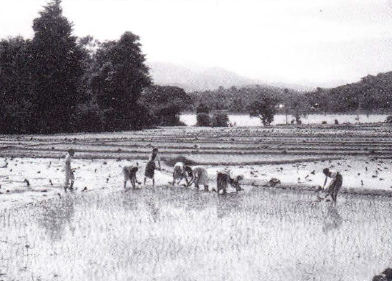What to look for in Sri Lanka in September

The sowing of good crops of paddy.
The meteorologists call September an inter-monsoonal month. It is the time when the monsoon blowing from the Indian ocean over the southwest coast, dies down and the northwest monsoon from India begins. Nights are delightfully cool, compensating for the daytime humidity.
In the hinterland of the countryside, a musky smell of burning rises to the nostrils. There is an ancient belief still prevalent that setting fire to scrub jungle, and the resulting yellow smoke steaming skywards, brings rain quickly and in great abundance to drown fields and help the sowing of good crops of paddy (rice).
Not only paddy. Mid- September to mid-October is the time when villagers in the country and jungles prepare fields and chenas (temporary plots) for maize, kurakkan, greengram, black peas; all types of gourds and chillies; onions, tomatoes and other vegetables.
Markets and roadside stalls sell fruits. An especially good bargain is avocado; pineapples, papayas and bananas are plentiful year round. It is the time for both wild and cultured varieties of orchids to blossom. Sheaves of exotic blooms, professionally packed, are available from good florists in the city.
Winged immigrants begin to fly in and this is a rewarding time of the year for bird watchers. Huge hawk eagles stand tall on rocky outcrops along the Wellawaya to Ella road and flocks of swallows screech in formation overhead. Waterbirds visit ponds, streams and marshes; chattering lapwings eternally cawk their rhetorical question, “Did-you-do-it?” and never stay for an answer.
By early October flocks of teal and wild duck are seen in the lagoons of Chilaw, Puttalam, Trincomalee and Batticaloa and in marshes on the east coast.
The ocean lapping the Galle Face embankment in Colombo gives a hint of the approaching tourist season as waves lose their monsoon ferocity; a sign that the west and south coast beaches are returning to peak condition.
The east coast is full of cultural activity at this time with Hindu kovils celebrating purification and thanksgiving rites to deities. with traditional festivals, processions and poojas (ceremonial offerings). There are elaborate festivals at Tirrukovil in the south east, at Kali temple at Eravur near Batticaloa and 8t Murugan Kandasamy kovil at Sithandy, 16km from Pasekudah beach.
The festive spirit prevails on tea plantations upcountry in spite of the daily routine of work as the descendents of South Indian immigrants worship Hindu gods . Age-old rites and rituals are held in small, mud-and-wattle kovils on the tea estates.
Flowers. f uits. coconuts and milk rice are offered by devotees. There is dancing in temple yards and processions. Visitors are welcomed under pandals (arches) of plantain trees festooned with king coconuts, bunches of npe plantains and mango leaves.
An important date for Muslims is October 2: Milad-Un-Nabi, the Holy Prophet’s birthday. There are religious celebrations in all the mosques m the island. For Buddhists. Poya days, the days of the full moon, September 4 and October 3, are observed in temples island-wide with alms-giving, devotional exercises and offerings to Buddha.

The month for poojas (ceremonial offerings) in Hindu temples.

